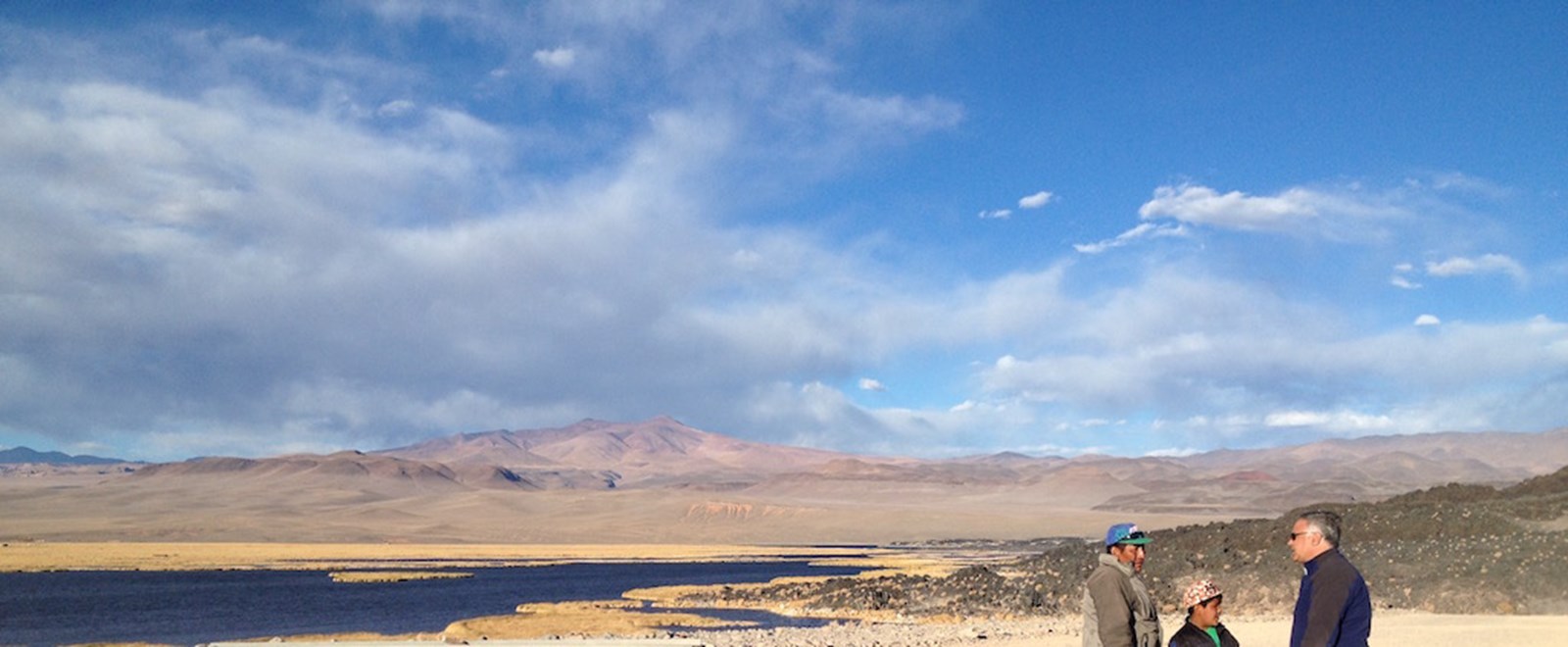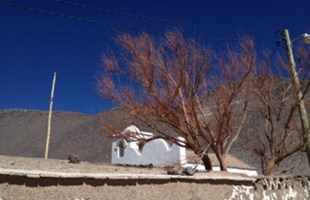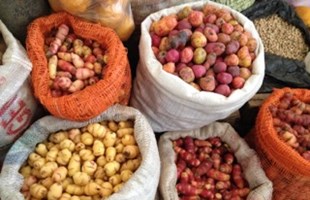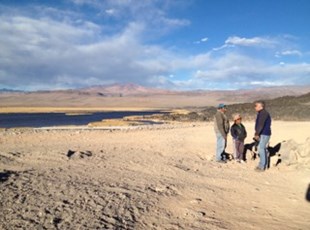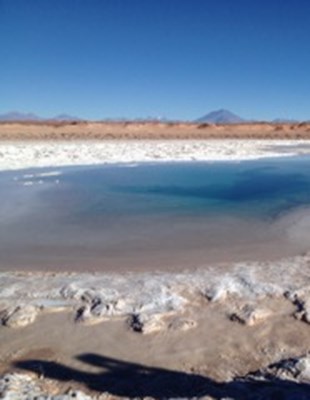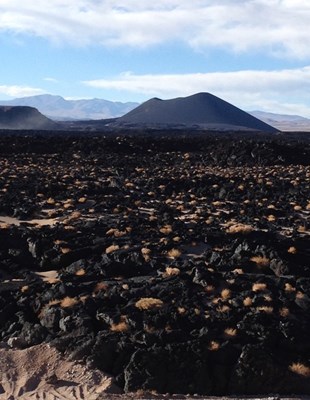The next morning dawned bright and clear, and we set off from Fiambala on what has got to be the most spectacular drive of my life. Federico told us the night before that we would be crossing the river 99 times. I stopped counting of course, but we drove that Toyota through an enormous amount of watery switchbacks, pretty unreal given the desert around us. Soon the rocky gorge gave way to a lake of flamingos, where we stopped to eat our milanesa sandwiches, the ‘drivetime’ food across all Argentina. We had not seen a soul all morning. We carried on to the Campo de la Piedra Pomez, water now a distant memory, to a spectacular landscape made of, as the name says, pumice. Here you can park up and climb the structures and pretend you are on the moon. The wind was strong but warm, but you felt the altitude with even the gentlest step. All around you there was a landscape of pink and white shapes. It was tempting to think about camping out here, in the remote wilderness, but just as you were thinking about it, a literally breathtaking gust of wind reminded you why there was no living thing on the rocks. At night, the sun would be gone and temperatures would plummet to below freezing. This may be beautiful, but it is a harsh, inhospitable terrain. We left reluctantly, marvelling at this bizarre and amazing place, with Federico blasting Wagner and muttering that it was only the beginning. The truck took a turn out of the white volcano, and then suddenly we were in the middle of a black lava field. Apparently the volcano had erupted Pompeii style, and had surprised everyone. Now, you could see the pitch black lava spread across the landscape, with yellow shrubbery running through it. Dramatic, beautiful and a very vivid reminder of the violence of the landscape we were in. As we drove on, the lava gave way to beautiful blue lakes and we saw the first life, a man and his son, since breakfast that day. All in a day.
The next day we left our frankly freezing Municipal guest house in Atofagasta de la Sierra and headed out. The sun was streaming through onto the crystal clear blue water where vicuñas; graceful, vulnerable and simply perfect were grazing peacefully. Lucky for them, pumas only hunt at night. As we drove through the altiplano we saw hundreds of vicuña on the hills, crossing roads neatly in single file, which seems the most dangerous of strategies. As we neared a small village, the more amusing and far less gracious llamas surrounded the fields, with their bright red and pink and orange bows on their heads, signifying that they had an owner. They do look jolly silly. Tasty though, as Julia who made us a ‘locro’, a local stew of llama meat demonstrated! We left the small house having had a quiet discussion about the prospects for young people in the area. Julia was immensely proud of her daughter, who was studying mining at the university. There is a lot of mining activity around here, lithium and silver, and jobs in mining companies are some of the safest for the local people. Lunch was followed by more vicuñas. Not that you can ever see too many vicuñas, but there were an awful lot of them, just pottering about. Looking pretty. Eventually we arrived at Tolar Grande, all vicuñad-out. Today’s major crisis is that there are only four bottles of wine left.
In Tolar Grande we stopped briefly to see the incredible saline lakes of stromatolites, guarded by a man and his dog. Extreme conditions are needed for these fossil formations, and there are not that many in the world. The altiplano throws up the most amazing random sites. Apart from the safety factor of having spare wheels, a tyre pressure monitor and an ever present altimeter to name a few of Federico’s gadgets, it is good to travel with a man who has guided in this place for over twenty years, and as a climber, has climbed, in most cases several times, all the volcanoes he points out to you. From here we worked our way to Susques, through now slightly more populated territory. Not that we saw people, but we saw more colourful grinning llamas than vicuñas, which meant that shepherds and villages were nearby. It’s weird, but after just a couple of days you get used to the dramatic scenery. We passed red volcanoes, black volcanoes and white volcanoes. And even some dull old brown ones. We aren’t going to stop for photos anymore unless we see zebras. Or desert elephants. I’m willing to stop for them. None were forthcoming, so we got to Susques to the quaint little town, where you can huddle by the locked doors of the school hall, which has the only wifi in town. You need a code – which every local knows, and gives out liberally to every passing visitor. Go figure.
A quick Instagram post by the school hall in the next morning, and we left for Tilcara. The route now is much more populated, there are more cars, definitely more llamas and a lot more people. Still, we find an isolated plain to eat our milanesa sandwiches and watch llamas in the distance. We set off down the road and Federico pulls up at what looks like the most random spot, and in a landscape that is stunning, there appears nothing to see. Ten yards from the road, there is a hole in the ground, with the most delicious hot spring where you can soak your feet. The crisp, cool breeze is on your face as your feet toast in the spring. We made our way to Tilcara, which is a buzzing town that feels like Goa, full of travellers and people just chilling out, a hippie town of the sixties. Here there are enough bars to have cocktails in one place, have llama steaks in another and coffee in a hip bookshop café. Very Parisian. Buenos Aires, eat your heart out.
The trip from Tilcara on our last day took us through through the colourful market town of Purmamarca, where we ate toasted cheese sandwiches in the street for lunch. We marvelled at the mountain of fourteen colours and then headed through the Jungas towards Jujuy. The landscape is now a verdant green, although the switchbacks are still with us. As we head through the outskirts of Salta, all you can think about is when you can return. I lament about the end, but Federico assures me: ‘it’s just the beginning’. He’s right. It’s the beginning of falling in love with the Argentine Altiplano where I will return to. But Federico has one last trick up his sleeve. We didn’t see any Pumas on our trip, but the Pumas are playing the Springboks in Salta. He’s got me a ticket. We (Pumas) won. 26:24. What a guy.
